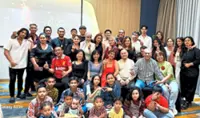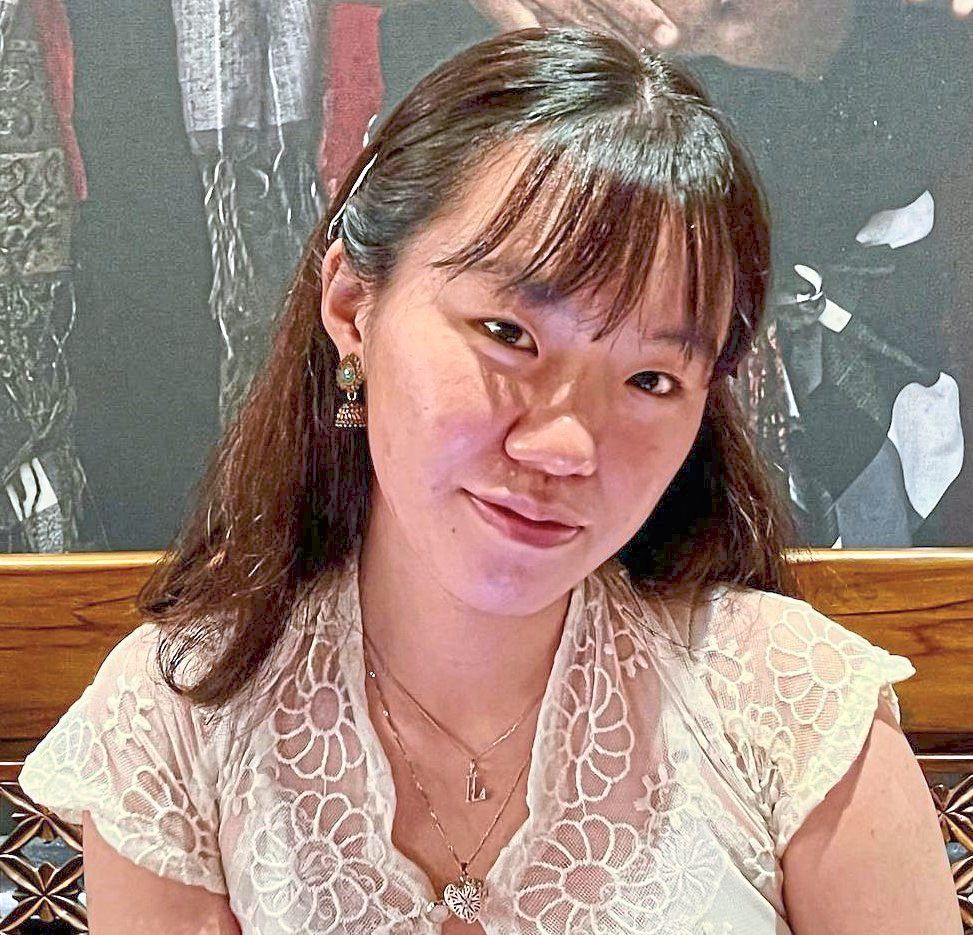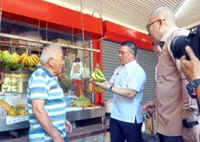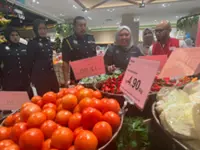Several of the garments in We Rent Fashion’s rental collection are from Shue’s personal closet. Photos: The Star/Raja Faisal Hishan
Ramadan – the sacred month leading up to Hari Raya Aidilfitri – is marked by fasting, spiritual reflection, communal prayers and festive preparations.
One thing stands out during this time: the rush of families shopping for new Hari Raya attire.
From bustling malls to pop-ups, families fill up stores in eager search for the perfect baju kurung and baju Melayu to don on Hari Raya. For many, this tradition is more than just about looking good for the auspicious day; it is deeply rooted in culture, a symbol of renewal and togetherness.
It is no surprise, therefore, that the expectation of buying new clothes every year has become a part of Hari Raya culture.
With the need to look the very best in photos posted on social media, materials like satin, organza, chiffon and lace adorned with delicate beadings and embroideries are taking centre stage.
Designer labels like Nurita Harith, Rizman Ruzaini and Hani Mokhta, among others, are offering these modern styles in their collections, fulfilling the wish lists of many.
But what happens after the celebrations are over?
Hari Raya apparel is often too elaborate to be worn for casual use – especially in Malaysia’s heat – leaving it stashed away in wardrobes indefinitely after being worn once or twice.
This cycle of consumption has significant consequences. According to data from the Solid Waste Management and Public Cleansing Corporation (SWCorp) and social enterprise Kloth Cares, fabric waste accounted for a staggering 31% – or 432,901 tonnes – of Malaysia’s total waste in 2021. That’s equivalent to a little more than the weight of four KL Towers.
Worldwide, the Global Fashion Agenda has estimated a total of 92 milion tonnes of global fashion waste produced each year – imagine a garbage truck dumping a full load of clothes into the landfill every second.
A change, however, is beginning to take place. More Malaysians are rethinking the need of buying new clothes for festive seasons like Hari Raya.
Sustainable alternatives such as renting and buying preloved Hari Raya outfits are gaining traction, offering a way to celebrate without breaking the bank while staying sustainable.
A new shift
One such advocate for this change is founder of We Rent Fashion, Suraidah Pudelani, 43.
Suraidah – also known as Shue – said that what started out as a way to fix her problem of obtaining clothes for Hari Raya has grown to become a solution for others as well.
We Rent Fashion offers an alternative to the cycle of buying new outfits every year. As the name suggests, the store specialises in renting designer clothes (including Hari Raya outfits) starting from RM15, up to RM50 a day for a minimum of three rental days, depending on the brand and collection.
“The fashion industry is one of the largest contributors to textile waste, and many traditional Hari Raya outfits are only worn once or twice before being stored away,” Shue explains.
“By offering rentals, we give people the option to enjoy beautiful, high-quality fashion without the long-term waste or cost. Our goal is to make sustainability effortless, stylish and accessible.”
The rental service has seen an increase in demand, especially among young professionals and urbanites aged between 18 and 45 years old who want to look stylish without spending too much.
“Hari Raya is our busiest season. People want to look their best while celebrating, but they also want to be more mindful about waste and spending,” Shue says.
She also notes an uptick in rental culture, especially with more and more individuals renting out their personal closet. “It’s not a new concept – you would always rent for your wedding or rent costumes for specific occasions. But renting for Hari Raya is quite new.
“However, we did notice in the past year or two, there has been a shift and a lot more people are now participating in this,” she adds.
What led to the idea of We Rent Fashion was her experience of not having any baju kurung when she came back to Malaysia from abroad towards the end of Ramadan.
“To buy a pair that is up to my standard, it’s super expensive. I’m a full-time housewife, so I don’t get to wear them everywhere. To spend a lot on a pair that I will be wearing only once or twice does not make sense.”
She recognised that the cycle will only continue on to the next year, where money will still be spent on garments that won’t be worn for long, only to wastefully find its way into the closet – or worse, the landfill.
“I tried to solve my own problem, then I realised that many others also share the same problem as me, too.”
Customers Darleen Zailin, 42, and Effy Eddy, 36, both from Selangor, say renting is an economical way to dress stylishly on Hari Raya.
“It allows me to wear a beautiful designer outfit without spending too much on something I might only wear once. Plus, it’s a more sustainable option compared to buying new clothes every year,” says Darleen.
As for Effy, having three children means that Raya preparations can get expensive. Opting to rent for the occasion provides a relief to the wallet.
“We only wear these outfits once or twice, so renting makes more sense. It’s also better for the environment because we’re not buying clothes we won’t use often.”
“Everyone wants to wear something new each year, and renting makes that possible without breaking the budget,” she adds.
Preloved market
Renting is not the only way to enjoy new apparel while staying sustainable; buying preloved (also known as thrifting) is also a great way – and it’s all the rage now.
For 19-year-old student Leya Kuan, perusing platforms like Carousell and Facebook Marketplace for secondhand Hari Raya outfits has become a routine.
For her, sustainability is just one of the reasons she opts for secondhand clothing. “The more you spend on clothes, the more you would want to keep them for special occasions only – I want to wear kebaya and baju kurung even when it’s not Hari Raya, so this fits into the bigger picture for me.”
A local business leading the change by selling preloved Raya outfits is Looop, a thrift store with curated collections for festive seasons like Hari Raya.
“One of the main reasons we started Looop is to create a circular economy within the local community,” says Looop co-founder Adani Bakhtiar, 28. “Some of the curated secondhand shops that we see in Kuala Lumpur often source from overseas, which doesn’t reflect our South-East Asian styles, brands, as well as Malaysian festivities.”
The store sees a diverse range of customers, from university students to working professionals and even a slightly older crowd – primarily female with a handful of male customers.
“There’s no denying that preloved clothes are cheaper and more affordable than brand-new pieces,” Adani explains. “We think people are also becoming more conscious about the ‘buy and wear once’ nature of festive wear, and are genuinely making the change to opt for more sustainable choices of Hari Raya clothing.”
However, Kuan, Darleen and Effy acknowledge that buying preloved and renting for Hari Raya comes with its own set of challenges.
“Sometimes you get actual vintage kebaya where the clasp has already rusted and left a stain on the clothing, or baju kurung where the elastic on the skirt has already loosened so you have to get it mended,” says Kuan.
Despite the challenges, Kuan adds that “it’s super worth it, because the clothes are unique, and they’re only RM50 at most.”
According to Darleen, sizing and availability are limitations that have to be kept in mind, especially during peak season when the most sought-after designs are quickly booked.
Effy agrees, but emphasises that We Rent Fashion provided her with ample options and a helpful team of staff, easing her rental experience.
Keeping the momentum going
While a shift toward sustainability is taking place, renting or buying preloved Raya attire remains a novel concept for many.
Darleen acknowledges this, stating that while renting for Hari Raya “is slowly becoming more popular, especially among younger generations who are more conscious about sustainability and saving money,” the long-standing tradition of buying new clothes holds strong.
It’s just a matter of sustaining and normalising this growing awareness – turning this practice into the mainstream for this festivity.
Looop is making preloved shopping more exciting by curating unique Hari Raya pieces through its consignment system, ensuring customers continue to experience the joy of finding something special.
“Based on great response over the previous years, we’re expecting more people to consider buying preloved this Hari Raya,” Adani says.
For We Rent Fashion, ease and accessibility is key. Shue emphasises the importance of making the rental process seamless and convenient to encourage more people to embrace it.
She also continues to refine her business for the better. “We learn about which types of fabric are more durable, so when we purchase clothes to rent out, we try to buy those in better fabrics that can last long.”
Kuan believes having more curated preloved stores can get more Malaysians open to renting or buying preloved for Hari Raya. “Obviously, not every thrift store has baju kebaya or baju Melayu lying around. You would have to pile through a lot of clothes just for one that might not even be your size, but that’s the joy of finding something that suits your taste and preferences.”
Darleen and Effy say there needs to be better awareness and incentives. “More people need to know how easy and affordable renting outfit is,” Effy says.
“If rental services offer more flexible return policies, discounts and a wider variety of traditional styles, I think more people might be willing to try it,” Darleen adds.
Ultimately, whether by renting or buying preloved, shifting towards a more sustainable Hari Raya wardrobe is a powerful step in breaking the cycle of waste.
The less new garments we purchase, the less brands produce – reducing overall fashion waste.
As awareness continues to grow and options expand, more Malaysians realise that celebrating Hari Raya in style does not have to come at the expense of their wallets and more importantly, the planet.
Towards a circular economy
Sustainabillity in fashion extends to more than just the clothes themselves, it is also about how the clothes are handled from start to finish.
We Rent Fashion founder Suraidah Pudelani, or Shue, ensures that sustainability is embedded in every stage of the rental process. After all, not only are they providing an alternative to purchasing brand-new clothes for the festive season, they also ensure that every step of the process minimises harm to the environment.
One of the ways is through their cleaning method. Instead of using harsh chemicals that can be damaging to both the fabric and the environment, Shue opts for biodegradable cleaning solutions and natural sunlight to dry the clothes.
Logistics is another area where they incorporate sustainability. Rather than relying on excessive packaging that will only be thrown away after usage, reusable bags – similar to the blue Ikea shopping bags – are used for garment delivery and returns.
On top of renting and selling preloved outfits, both We Rent Fashion and Looop provide an accessible way for others to participate in the circular fashion economy through the consignment system.
Customers can lend their own clothing to be rented out at We Rent Fashion or sold at Looop as a preloved item (including festive pieces, which are welcomed by them). On Shue’s part, this journey is about paving a path for herself and others to be more conscious about fashion choices.
“Since a young age, I’ve always loved fashion. I’m not in the industry, but I realised how badly it impacts the environment. I feel guilty about it because I know I contribute to that,” she says.
“Whatever it takes to prolong the life of clothes – either through rental services or selling and buying preloved – will help the environment greatly in the long run.”














